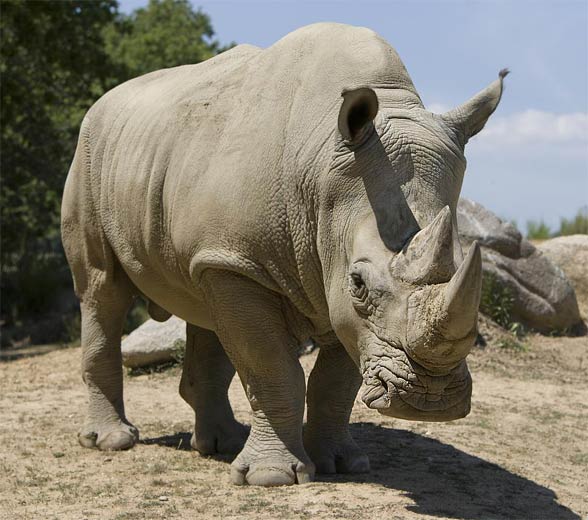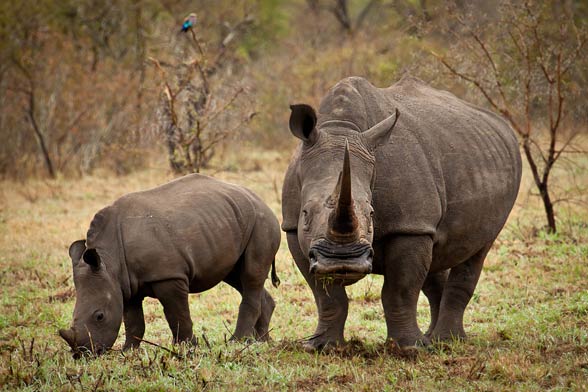White rhinoceros (Ceratotherium simum)
Square-lipped rhinoceros
It is the biggest and the most numerous species out of rhinoceros living at present. It is also the most characteristic representative of African fauna next to the lion, the zebra and the giraffe. Although it has fair colored skin, its species name is not derived from it, but from the wrong translation.
Classification
- Kingdom: Animalia
- Class: Mammalia
- Order: Perissodactyla
- Family: Rhinocerotidae
- Genus: Ceratotherium
- Species: Ceratotherium simum
- Names: white rhinoceros, square-lipped rhinoceros

Name
The most popular theory says that ‘the white rhinoceros’ is derived from the incorrect translation from Dutch to English. The English word ‘white’ was associated with the Dutch word ‘wijd’ meaning wide, which referred to the animal’s shape of the mouth. This way, English-speaking settlers in South Africa considered the square-lipped animal as the white rhinoceros.
Ironically, the same language calque was used later by the Dutch and the Afrikaners. This name was preserved by Dutch writers and the ‘wijd’ word has probably never been used apart from the oral language.
Another theory is that the word ‘wide’ has no reference to the rhinoceros appearance but its wide range of distribution on the continent. It can also have the connection with its skin color left by calcareous soils or birds’ feces which rhinos wallow in.
The name Ceratotherium was introduced by John Edward Gray in 1868. It is derived from Greek and combines the word Keras – ‘horn’ and Therion – ‘beast’. The second part – Simum – comes from the Greek simus – ‘flat nosed’.
Therefore, we present the flat nosed beast with the horn – the white rhinoceros – which is better not to interfere with…

Distribution
There are two subspecies of the white rhinoceros and each of them exists on different areas.
Northern white rhinoceros (Ceratotherium simum cottoni)
We think that the species is critically endangered or extinct in wild. In the past, it lived in the eastern and central Africa, in the south of the Sahara. It grazed on grasslands and savannahs. At present, there are only 3 species in captivity and 4 species were introduced to Kenya.
At the beginning, six species lived in the zoo – Dvur Kralove Zoo in the Czech Republic but 4 of them were transported to Ol Pejeta – the Kenyan natural reserve, where the scientists are trying to breed the population and save the species against the total extinction.
One of two species left in the Czech Republic died in May 2011. Two northern white rhinoceros also stay in Safari Park in San Diego (state: California).
Recent phylogenetic studies have shown that the subspecies can be the totally different species of the rhinoceros, which is suggested by distinct morphological and genetic differences.
Southern white rhinoceros (Ceratotherium simum simum)
Estimates given at the end of 2007 suggest that there are 17 460 species in wild. The Republic of South Africa is the stronghold for the subspecies and 93% of all population of these animals lives there. Smaller groups exist in Namibia, Botswana, Zimbabwe and Swaziland. Small population has also survived in Mozambique. The subspecies were reintroduced in Kenya, Uganda and Zambia. They reproduce unwillingly in captivity for unknown reasons.

Characteristics
Appearance
The white rhinoceros is the biggest of five other rhinoceros species. It has the massive body, the short neck and the wide chest. The body length is 3,7 – 4 m (12 – 13 ft), the tail is about 70 cm (27.6 in) long. The height in shoulders among males is between 1,7 – 1,85 m (5.6 – 6 ft) and among females 1,6 – 1,77 m (5.2 – 5.8 ft). The animal is very heavy and it weighs from 1360 to 3630 kg (2998 to 8002 lb); males are heavier.
The horn
Horns can be noticed on the snout and they are placed one after the other and they are made of keratin. This differentiates them from the deer antlers made of the solid bone. The front horn is longer (90 – 150 cm [35-59 in]) and wider at the bottom than the back one.
On the back of its neck, there is the specific hump and each of four feet has three thick toes.
Marking
The skin color ranges from yellowish brown to the shades of gray. There is no hair except for the top of its tail and the ear fringes.
The characteristic snout
Its wide blunt snout is a distinguishing feature and its lips are adjusted to scavenging on savannas. Its ears move independently so as it could hear better but it trusts most its smell. It has got very small eyes placed on head sides.

Diet
The white rhinoceros grazes on grassland plains in Africa – it eats a huge amount grass. The effective consumption is facilitated by its square lips, which can imply a lot of food. Thanks to it, the rhinoceros can saturate faster which differentiates it from the black rhinoceros (Diceros bicornis) having thin lips in the form of ‘the beak’ which makes it easier to pick up fruits and leaves from tree branches as well as bushes.
While gazing, it walks peacefully around with its head placed near the ground like a slow hover.
It tries to find a small waterhole every day, but it can stand without it for 4-5 days if it is necessary. All rhinoceros have the poor sight but good hearing and smell.
It spends almost half of a day eating, one third – relaxing and the rest is for other activities.

Lifestyle, behavior
The white rhinoceros is considered the most civilized among other rhinos. Females are usually seen with their young, which stay close to their mother until it gives the next birth.
It can form temporary groups consisting of 14 immature species or lonesome females. Dominating males usually stay lonely and occupy smaller areas than females. Borders are created with urine sprayed dung piles marked with prints of hooves on the soil and their horns destroy plants. Subordinate males do not mark the boundaries of their territories.
The demonstration of strength
Although the male tolerates females and immature male species on its area, it would try to force them to leave the terrain, which is not theirs. Nobody has witnessed the situation when the male immediately confronts this kind of the intruder. Fights happen frequently and they are not bloody – they involve the horn presentation, the demonstrative charge and other ‘show-offs’ which are performed to drive the unwilling guest away.

Why does the rhinoceros wallow in the mud?
The white rhinoceros often look for the shade, which would protect them against hot African sun and where they could lie or wallow peacefully if there is some water or mud around. The animal does not do it because of boredom but for health reasons- the mud on its skin cools it and protects the animal against the sunburn as well as it repels obsessive insects.
Vocalizations (sounds)
The white rhinoceros produce various wheezing sounds. It rumbles and spits during the courtship. When it is endangered, it squeals or growls in deepness. Encircled males rub the ground with their horns, put ears and growl; during the attack, they shout.
Speed
Despite its big size and not slender build, it can reach the speed of 50km/h (31 mph).

Reproduction
The white rhinoceros can reproduce at any time but it is not too emotionally stable J The relationship between the male and the female is from 1 to 3 weeks long and after that, the female partner must leave the territory of its ex-companion.
The courtship of rhinoceros – foreplay
At the beginning, it is the female, which rules – the male behaves in a subtle way because its partner often shows the aggression if the male comes too close crossing its territory boundary. When everything goes as planned, the male starts chasing the female blocking its way out or gives out loud wails when it tries to walk away.
The young
After the 30 minute coupling, the female becomes pregnant and this period lasts 16-18 months. After that, there is one young born weighing from 40 to 65 kilos (88 to 143 lb). During first two or three days, it is very frightened and unsure about its surroundings. When it feels under threat, it runs towards its mother and stays close to its front legs. As the mother is very caring, it protects its young vigorously.
The lactation lasts around 2 months, but the calf can be bred with milk for a year or two; therefore, females give birth approximately every 2-3 years. Before the next birth, the pregnant animal chases off its current calf.
In adult life, the young will not have natural enemies because of the size, but it also rarely happens that it is the victim of predators during the childhood period because the mother and the thick skin are great forms of protection. Females become sexual mature at 6-7 years old whereas males at the age of 10-12 years old.

The rhinoceros horn – the symbol of pride and the reason of extinction
The grand front horn, which is the distinguishing mark of this animal, has also become the reason for its fall. Many species have been shot by poachers, which cut off horns and later used them as cures in traditional medicine in China, Taiwan and Singapore. The horn is also precious as decorative halves of daggers in North Africa and the Middle East. The animal does not have to be killed for the trophy – horns grow out just as hair.
Rhinoceros die because of its horn
Despite the strong protection, the amount of killed rhinos is bigger. In 2007, 13 species died; in 2008, it was 83 animals and in 2011, 448 rhinos were killed. More details are presented on the chart below.
The price of the horn on the black market
Below, we present some comparisons thanks to which many people may realize why despite the danger of being imprisoned, many people decide to kill rhinoceros.
- 1kg (2.2 lb) of cocaine – around 30.000 USD
- 1kg (2.2 lb) of gold – around 43.000 USD
- 1kg (2.2 lb) of platinum – around 60.000 USD
- 1kg (2.2 lb) of rhino’s horn – around 60.000 USD
One kilo of the rhino’s horn costs as much as the kilo of platinum on the black market…

Detailed information and size:
The white rhinoceros (Ceratotherium simum)
- The biggest living rhinoceros and the second largest land animal
- Height at shoulders: males: 1.7-1.86 m (5.6 – 6.1 ft); females: 1.6-1.77 m (5.3-5.8 ft)
- Body length: males: 3.7-4 m (12.1 to 13.1 ft); females: 3.4-3.65 m (11.2 – 12 ft)
- Weight:
- males: 2,000 – 2,500 kg, average 2,300 kg (5,100 lb), the big rhinos can weight 3,600 kg (7,900 lb); the record – holder weighed 4500 kg (9921 lb)
- females: 1500 – 2000 kg, average 1700 kg (3,700 lb)
- The length of the tail: 70 cm (28 in)
- The white rhinoceros has got two horns. The bigger horn is up to 150 cm (59 in) long (average 60 cm (24 in).
- Lifetime: 40 – 50 years
- Speed: up to 50km/h (31 mph)
- The white rhinoceros are less aggressive than the black rhino

The white rhinoceros – curios
- The white rhinoceros is the third biggest land animal after the African elephant (Loxodonta africana) and the Asian elephant (Elephas maximus).
- It has the widest nostrils among all land animals.
- It has the great smell – it can find another rhinoceros, which passed over the specific territory.
- It has lived on the Earth for 50 million years.



















